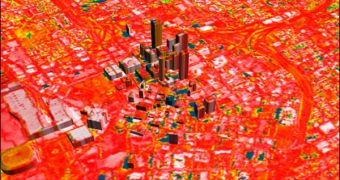Finding ways of reducing the urban heat island effect has been a goal for researchers ever since the phenomenon was first discovered. Now, an Arizona State University (ASU) expert is proposing new ways of handling this evolving problem.
The urban heat island effect occurs when cities heat up much more than their surroundings. During the winter, some of the world's most populous cities may not even experience snow, but rather only rain. This happens because heat rising from the city simply melts the snow before it can land.
One of the most important contributors to this effect is the layer of dark pavement covering all streets and some sidewalks. During the day, it collects heat from the Sun, only to diffuse it back into the air during the night.
In some instances, the effect is so intense that a city may register temperatures 20 degrees Fahrenheit higher than their surrounding areas. One thing that exacerbates this phenomenon is the fact that people use more electricity to cool down their homes.
However, increased air pollution and greenhouse gas concentrations harm the environment, causing an increase in global warming, which then further contributes to the urban heat island effect indirectly.
In addition to being uncomfortable, excessive heat can lead to a number of health problems, so it would be in everyone's best interest to keep this effect as unobtrusive as possible. However, that requires numerous changes to be made to the city's infrastructure, which is expensive.
“If you look at the surfaces in an urban city like Phoenix, sidewalks, parking lots, roadways and highways are about 40 to 45 percent of the overall landscape cover. That’s why we should think about roadways when we talk about the urban heat island effect,” says Kamil Kaloush.
The expert holds an appointment as an associate engineering professor at ASU, and is a faculty member in the School of Sustainable Engineering and the Built Environment. He also directs the ASU National Center of Excellence for SMART Innovations,
“During the day most materials are hot. But what we’re concerned with here in the Southwest region is nighttime mitigation. When people go to their homes and get active with outdoor activities, you really want to have a cool environment as much as possible,” he says,
Kaloush explains that the density and reflectivity of the pavement is a decisive factor in determining how much heat it absorbs, and how fast it releases it during the night. “Usually dense materials conduct heat at a faster rate,” he explains.
According to his studies, highways that are embedded lower in the ground, and those that are shielded by noise walls tend to be a lot hotter than others. Interestingly, traffic actually cools the surface of roads, unlike parking lots where the cooling effect is not obvious.
“Roadways are a big part of the urban landscape, and we can design them in different ways that actually work for our benefit,” the ASU investigator says.
“Having all roadways white or black is not going to be the solution for all. We need to think through and evaluate different designs that are best suited and effective for what you are trying to achieve overall,” he concludes.

 14 DAY TRIAL //
14 DAY TRIAL //